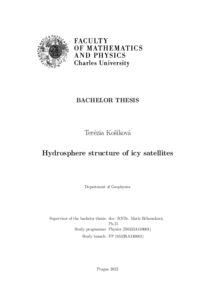Hydrosphere structure of icy satellites
Struktura hydrosféry ledových měsíců
bachelor thesis (DEFENDED)

View/
Permanent link
http://hdl.handle.net/20.500.11956/184040Identifiers
Study Information System: 252474
Collections
- Kvalifikační práce [11363]
Author
Advisor
Referee
Kalousová, Klára
Faculty / Institute
Faculty of Mathematics and Physics
Discipline
Physics
Department
Department of Geophysics
Date of defense
5. 9. 2023
Publisher
Univerzita Karlova, Matematicko-fyzikální fakultaLanguage
English
Grade
Excellent
Keywords (Czech)
ledové měsíce|led|termodynamické vlastnosti|strukturaKeywords (English)
icy satellites|ice|thermodynamic properties|structureSkúmanie potenciálneho života na iných nebeských telesách v rámci Slnečnej Sústavy je jednou z kľúčových otázok planetárnej vedy. V tejto práci sme sa zamerali na určenie hydrosféry ľadových mesiacov Ganymede a Europa, aby sme určili možné prekážky v obývateľnosti v dôsledku prítomnosti vysokotlakových fázy ľadu. Použili sme známe termodynamické vlastnosti a parametre satelitov na vytvorenie algoritmu, ktorý určil ich štruktúru. Zistili sme, že na Ganymede sú vysokotlakové ľady prítomné v širokom rozsahu tlakových a teplotných podmienok, ktoré môžu brániť prenosu minerálov medzi silikátmi a podpovrchovým oceánom. Pre Európu sme zistili, že výskyt vysokotlakových ľadových fázy je v jej hydrosfére veľmi nepravdepodobný. Najnovšie údaje pre Európu však komplikujú presné určenie jej štruktúry a Európa môže obsahovať tenšiu hydrosféru a oceán, ako sa pôvodne predpokladalo. 1
The exploration of potential life on other celestial bodies within the Solar System is one of the key questions in planetary science. In this work, we focused on determining the hydrosphere of the icy moons Ganymede and Europa in order to determine possible obstacles in habitability due to the presence of the high-pressure ices. We used known thermodynamic properties and satellite parameters to create an algorithm that deter- mined their structures. We found that on Ganymede high-pressure ices are present in a wide range of pressure and temperature conditions, which may prevent the transfer of minerals between the silicates and the subsurface ocean. For Europa, we found that the occurrence of high-pressure ice phases is very unlikely in its hydrosphere. However, the latest data for Europa complicates the exact determination of its structure and Europa may contain thinner hydrosphere and ocean than originally thought. 1
